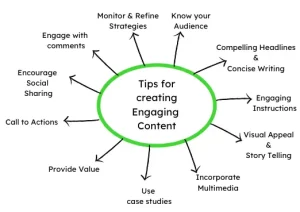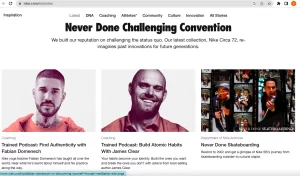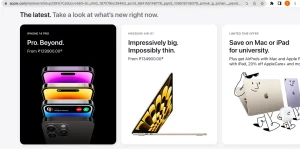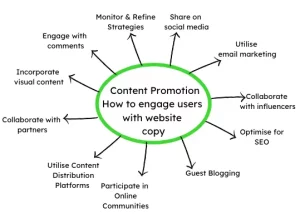How To Write Engaging Content For Website?
Three tips to create engaging content include making attention grabbing headlines, a story that convinces the readers, and sharing valuable information.
Days that content is created for heck of it is already a pass. Now if you want the audience to engage with your content, you have to maintain consistency and remember a few tricks.
Dive in to know how to create engaging content.
What is Engaging Content?
Content that captures the minds and the attention of the audience is engaging content. It could be any material, such as articles, blog posts, videos, or social media posts.
Content that resonates with the target audience, sparks their interest, and encourages them to interact, share, or take further action.
Engaging content goes beyond simply delivering information. It evokes emotions, provides value, and connects with the audience. It is often original and unique and offers a fresh perspective or insight. Engaging content may be entertaining, informative, educational, inspiring, or thought-provoking, depending on the goals and preferences of the target audience.
The key characteristics of engaging content include the following:
- Relevance: It addresses the target audience’s interests, needs, or challenges. Engaging content is tailored to the specific demographic, industry, or niche it aims to reach.
- Compelling storytelling: It tells a captivating story or narrative that grabs the audience’s attention and keeps them engaged. Storytelling can help convey messages, evoke emotions, and create a memorable experience.
- Visual appeal: Engaging content often incorporates visually appealing elements, such as high-quality images, infographics, or videos. Visuals can enhance the message, make it more digestible, and increase audience engagement.
- Interactivity: It encourages audience participation and interaction. Engaging content may include polls, quizzes, surveys, contests, or calls to action that prompts users to comment, like, share, or contribute their thoughts.
- Authenticity: Engaging content is authentic, transparent, and genuine. It establishes trust with the audience by being honest, relatable, and demonstrating a human touch.
- Value: Engaging content provides value to the audience. It educates, entertains, solves problems, or offers practical tips, insights, or advice. Valuable content is more likely to be shared, bookmarked, or revisited by the audience.
- Format variety: Engaging content can take various formats, such as articles, videos, podcasts, infographics, or interactive webinars. Diversifying the content format can cater to different audience preferences and increase engagement.
Also Read: What is Copywriting? How to Create a Compelling Copy?
Important Tips For Engaging Content
These are the tips for creating engaging content for websites, articles or a copy.
Creating engaging content for your website is essential for attracting and retaining your audience’s attention. Here are some detailed tips to help you create engaging content:

Know Your Audience:
Understand your target audience’s demographics, interests, and pain points. Conduct market research, analyse audience data, and gather feedback to develop content that resonates with their needs and preferences.
Compelling Headlines:
Craft attention-grabbing headlines that pique curiosity, promise value, or evoke emotions. Use powerful words, numbers, and persuasive language to entice readers to click and explore further.
Clear and Concise Writing:
Write clearly, concisely, and conversationally. Break content into digestible paragraphs, and use subheadings, bullet points, and visuals to enhance readability and make it easier for readers to skim through the content.
Engaging Introductions:
Hook readers with engaging introductions that immediately capture their interest. Pose questions, share intriguing facts or anecdotes, or highlight the benefits they can gain from reading further.
Visual Appeal:
Incorporate visually appealing elements such as high-quality images, infographics, videos, or interactive media. Visuals can break up text, make content more engaging, and help convey information effectively.
Storytelling:
Use storytelling techniques to create a narrative that resonates with your audience. Engaging stories evoke emotions, connect with readers personally, and make the content more memorable.
Incorporate Multimedia:
Include multimedia elements such as videos, podcasts, or slideshows to provide a richer and more interactive experience. Different media formats cater to diverse learning styles and preferences.
Use Examples and Case Studies:
Illustrate your points with real-life examples and case studies that showcase practical applications of the concepts or ideas you’re discussing. This adds credibility and makes the content more relatable and actionable.
Provide Value:
Offer valuable insights, practical tips, or actionable advice that address your audience’s challenges or interests. Be informative and educational, and provide solutions to their problems. Value-driven content encourages readers to engage and share it with others.
Call to Action (CTA):
Include clear and compelling CTAs to guide readers on the next steps. Whether it’s encouraging them to comment, share, subscribe, or take advantage of a special offer, CTAs prompt audience interaction and increase engagement.
Encourage Social Sharing:
Integrate social sharing buttons to make it easy for readers to share your content on their preferred social media platforms. This amplifies your reach, increases visibility, and stimulates conversations around your content.
Engage with Comments and Feedback:
Actively engage with your audience by responding to comments, answering questions, and seeking feedback. Encourage discussion, show appreciation, and foster community around your content.
Analyse and Optimise:
Continuously monitor and analyse the performance of your content using web analytics tools. Track metrics such as engagement, time on the page, bounce rates, and social shares. Use the insights to refine and optimise your content strategy.
Knowing how to write engaging articles is not a challenge. It happens in real life because the articles that connect with the readers helps a brand get more traffic than is expected. You can read this example to understand how to write engaging articles.
Brand Example That Creates Engaging Articles
One brand that is known for creating engaging content is Nike. Nike consistently produces captivating and inspiring content that resonates with its target audience. They leverage powerful storytelling techniques, visually stunning videos, and compelling narratives to create an emotional connection with their customers.

Nike’s content often focuses on empowering individuals to push their limits, showcasing the journeys and achievements of athletes, and promoting a message of perseverance and determination. Nike’s content captures attention, sparks inspiration, and encourages audience engagement by tapping into the universal themes of motivation, dedication, and overcoming obstacles.
Whether it’s their iconic “Just Do It” campaign or its thought-provoking advertisements featuring athletes from diverse backgrounds, Nike has mastered creating engaging content that aligns with its brand identity and resonates with its audience.
Brand Example That Create Engaging Copy
One brand that excels in creating engaging copy is Apple. Read to know how to write engaging copy.
Apple’s copywriting is known for its simplicity, clarity, and emotional appeal. They use concise and powerful language that connects with their audience deeply. Apple’s copy highlights its products’ unique features and benefits in a way that resonates with consumers’ aspirations and desires.
For example, their tagline “Think Different” is a powerful statement that taps into the desire for innovation and creativity. It captures attention and encourages individuals to break free from the status quo.
Apple’s product descriptions and marketing campaigns often use compelling narratives, emphasising how their products can enhance people’s lives, spark inspiration, and enable them to achieve more.
Apple’s website copy is designed to guide customers through its product offerings, using clear and persuasive language to explain the features and benefits. They create a sense of anticipation and desire through their copy, making customers feel that owning an Apple product will enrich their lives and elevate their experiences.
By crafting engaging copy that focuses on the unique value and emotional connection, Apple successfully captivates its audience and motivates them to embrace its brand and products.
Content Promotion-How to engage users with website copy?
Knowing how to create content to engage users with the website copy is important if you want to win the competition in the market.
Promoting your content is essential to engage users with your website copy.
Here are some effective strategies to promote your content and drive user engagement:

Leverage popular social media platforms like Facebook, Twitter, LinkedIn, or Instagram to share your content. Craft compelling captions or teasers encouraging users to click and engage with your website copy.
Utilise Email Marketing:
Build an email subscriber list and send regular newsletters or updates featuring your content. Personalise your emails, segment your audience, and include enticing previews or summaries to encourage users to visit your website.
Collaborate with Influencers:
Identify influencers or industry experts who align with your brand and audience. Collaborate with them to share your content with their followers, leveraging their credibility and reach to drive engagement.
Optimise for SEO:
Implement search engine optimization techniques to improve the visibility of your content in search engine results. Conduct keyword research, optimise meta tags, headers, and URLs, and create high-quality, keyword-rich content to attract organic traffic.
Guest Blogging:
Write guest posts for popular blogs or publications in your industry. Include links to relevant content on your website within the article to drive traffic and engage readers interested in your niche.
Participate in Online Communities:
Engage in online forums, groups, or communities relevant to your industry. Share your content when appropriate, provide valuable insights, and establish yourself as an authority in your field to attract users to your website.
Utilise Content Distribution Platforms:
Submit your content to content distribution platforms such as Medium, LinkedIn Articles, or SlideShare. These platforms have built-in audiences, allowing you to reach a wider user base and drive traffic back to your website.
Collaborate with Partners:
Partner with other businesses or organisations with a similar target audience. Cross-promote each other’s content, co-create content, or participate in joint webinars or events to expand your reach and engage new users.
Incorporate Visual Content:
Create visually appealing content such as infographics, videos, or slideshows. Share these on platforms like YouTube, Pinterest, or SlideShare to attract users who prefer consuming visual content.
Engage with Comments and Feedback:
Actively engage with users who comment on your content or provide feedback. Respond to their comments, answer questions, and encourage further discussions to foster community and promote continued engagement.
Monitor Analytics and Refine Strategies:
Regularly monitor analytics to assess the performance of your content promotion efforts. Identify what channels are driving the most engagement and adjust your strategies accordingly.
Conclusion
Crafting website content that genuinely engages people is essential for building a thriving online presence. To achieve this, understand your audience, create a clear and compelling message, utilise storytelling techniques, incorporate visuals, prioritise readability, and encourage interaction.
By implementing these strategies, you can captivate your audience, foster meaningful connections, and drive action. If you want engaging content for your website, don’t hesitate to contact us. Our team at Noboru World is here to help you create captivating content that resonates with your audience.
FAQ
How do I create engaging website copy?
To create engaging website copy, understand your target audience and their needs. Craft clear and compelling headlines that grab attention. Communicate the unique value and benefits of your offerings. Use persuasive language, storytelling techniques, and visuals to create an emotional connection. Break up the text for readability, incorporate interactive elements, and provide social proof. Continuously test and optimise your copy based on user feedback and behaviour.
What tone should I use in my website copy?
The tone of your website copy should align with your brand identity and resonate with your target audience. It can be conversational, friendly, professional, or authoritative, depending on your brand personality and the nature of your products or services. Tailor the tone to create a connection with your audience and evoke the desired emotional response.
How long should my website copy be?
Website copy length can vary depending on the purpose and complexity of your offerings. Generally, aim for concise and scannable content. Provide enough information to communicate value and address user concerns, but avoid overwhelming readers with excessive text. Break up the content into sections, use bullet points, and utilise headings to improve readability.
Should I use keywords in my website copy for SEO?
Incorporating relevant keywords in your website copy can improve search engine optimization (SEO). Research keywords that align with your content and incorporate them naturally within your copy. However, prioritise writing for your audience and maintain a conversational tone. Quality content engages readers, so avoid keyword stuffing or sacrificing readability for SEO purposes.
How can I measure the effectiveness of my website copy?
Use analytics tools to track key metrics such as page views, time on page, bounce, and conversion rates. These metrics provide insights into how users engage with your website copy. Monitor user feedback, comments, and inquiries to gauge audience response. A/B testing different variations of your copy can also help determine what resonates best with your audience and drives higher engagement and conversion rates.




